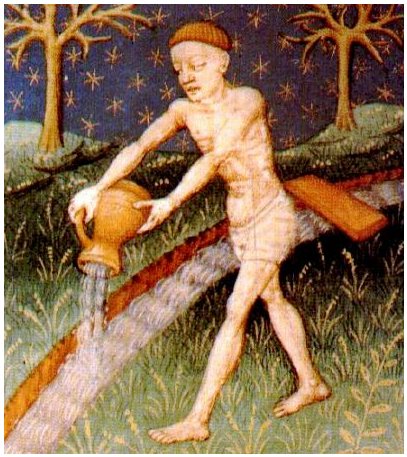5. Alrai,'the shepherd', is located just before spring equinox north of the equator and I cannot believe it is just a coincidence that the Babylonian zodiac has True Shepherd of Anu where the Milky Way crosses the ecliptic on its way down. Was Cepheus a shepherd? I search in Allen's book but cannot find any definite answer to my question. Evidently also the ancients were uncertain. Wikipedia delivers the following: "The Babylonian star catalogues of the Late Bronze Age name Orion MULSIPA.ZI.AN.NA, 'The Heavenly Shepherd' or 'True Shepherd of Anu' - Anu being the chief god of the heavenly realms. The Babylonian constellation was sacred to Papshukal and Ninshubur, both minor gods fulfilling the role of 'messenger to the gods'. Papshukal was closely associated with the figure of a walking bird on Babylonian boundary stones, and on the star map the figure of the Rooster was located below and behind the figure of the True Shepherd." If - as I have suggested - we should define the era of Orion as the time long ago when this constellation (always standing at the crossroads between the rising ecliptic straight path and the sinking undulating Milky Way river) was at spring equinox north of the equator, and if this great 'Golden Age' was described by the form of a cross in time-space, then we should not be astonished to find the imprint of 'shepherd' also at winter solstice, where we provisionally have located Alrai. The cross belonged to Orion, the heavenly shepherd, and as a Sun-god he could be imagined to be 'born' at winter solstice, at the top end of the cross, where his living spirit alighted to take command of the world below anew each year. A quarter earlier than the True Shepherd of Anu we can find the Great One, standing on a Fish which seems to be swimming at the bottom of a kind of stream:
"Aquarius is identified as GU.LA 'The Great One' in the Babylonian star catalogues and represents the god Ea himself, who is commonly depicted holding an overflowing vase. The Babylonian star-figure appears on entitlement stones and cylinder seals from the second millennium. It contained the winter solstice in the Early Bronze Age. In Old Babylonian astronomy, Ea was the ruler of the southernmost quarter of the Sun's path, the 'Way of Ea', corresponding to the period of 45 days on either side of winter solstice. In the Greek tradition, the constellation became represented as simply a single vase from which a stream poured down to Piscis Austrinus. The name in the Hindu zodiac is likewise kumbha 'water-pitcher' ..." (Wikipedia) Our current day number for Alrai is 359 (counted from spring equinox north of the equator) and I doubt glyph number 'zero' (Gb6-19) corresponds to Alrai. Instead I propose glyph number 359 (tagata rima aueue, cfr at Glyph Types) as a more likely candidate, which would explain the 'flowing arms':
However, 42 days later, in Gb6-18 (a Saturday) a kind of flow can also be imagined, and the 'balloon' in front is great. And King Cepheus far up close to the source of the Nile was the father of Andromeda: "Perseus reached Ethiopia to find the country in a state of desolation. Cassiopeia, wife of the king, Cepheus, had offended the Nereids by proclaiming that she was more beautiful than they. In this quarrel Poseidon had taken the part of the Ocean nymphs and sent a marine monster to devour men and beasts. When the oracle of Ammon was consulted he answered that only Andromeda, daugher of King Cepheus, could save the country by offering herself as a victim to the monster. When Perseus arrived on the scene he found the unhappy Andromeda chained to a rock, awaiting death. He fell in love with her at first sight. The sequel may be guessed: he killed the monster, freed Andromeda and married her ..." (New Larousse Encyclopedia of Mythology) Support for my idea that tagata rima aueue in Gb5-5 is referring to Aquarius is found by counting 45 glyphs back, because 359 - 45 = 314 (100π) and the glyph line is b3 - where there is no sign of henua. Sirrah (α Andromedae) is at present rising 1 day beyond spring equionox north of the equator and I have suggested Rogo in Gb6-26 corresponds to Sirrah. Perhaps there are 45 days to Alrai counted beyond the completed cycle in Gb3-23 and a further 45 days beyond vaha kai in Gb5-10 to Sirrah:
In between these 45-day periods there could then be 5 intercalendar dark nights, in the center of the quarter of 'water' ruled by King Cepheus.  |
|||||||||||||||||||||||||||||||||||||||||||||||||||







